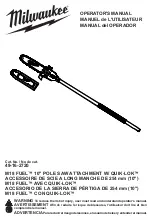
LEROY MERLIN
– Rue Chanzy – Lezennes 59712 LILLE Cedex 9 – France
21 / 40
the user should at least be able to make a better as-
sessment of the dangers and risks involved.
Reduce noise generation and vibration to a mini-
mum!
• Use only equipment that is in perfect condition.
• Maintain and clean the equipment regularly.
• Adopt your way of working to the equipment.
• Do not overload the equipment.
• Have the equipment checked if necessary.
• Switch off the equipment when not in use.
7. Before starting the machine
Important.
Always pull out the power plug before making adjust-
ments to the equipment.
7.1 General information
• All covers and safety devices have to be properly
fitted before the equipment is switched on.
• It must be possible for the blade to run freely.
• When working with wood that has been processed
before, watch out for foreign bodies such as nails
or screws, etc.
• Before you actuate the On/Off switch, make sure
that the saw blade is correctly fitted and that the
equipment’s moving parts run smoothly.
• Check that the voltage on the rating plate is the
same as your supply voltage before you connect
the equipment to the power supply.
• Only ever connect the equipment to a properly
installed shock-proof socket which is protected by
a 10A fuse as a minimum.
7.2 Installing the fretsaw on a workbench (Fig.
3, 4)
The unit may only be installed by a professional.
Required for installing (not provided):
• M6 hex screw (4x)
• M6 hex nut (8x)
• Washer, Ø 7 mm (4x)
• Flat gasket, Ø 7 mm (4x)
• Rubber base: 410 x 255 x 13 mm
The length of the screws to be used varies, depend-
ing on the thickness of the table top.
• Install the fretsaw on a work table made from solid
wood. This will avoid excessive noise caused by
vibrations.
• Mark the drill holes. Use the fretsaw as a template
for this purpose.
• Drill 4 holes with a diameter of 9 mm into the work
table and the rubber base.
• Screw the fretsaw to the table using the mount-
ing points (Fig. 3/12, Item 16) and in the following
sequence (Fig. 4):
A) Fretsaw
B) Rubber base
• Damage to hearing if no suitable ear protection is
applied
• Contact with the blade in the uncovered cutting
zone
• Injuries (cuts) when changing the blade
•
Crushed fingers
• Kickback
• Tilting of the workpiece due to inadequate support
• Touching the blade
• Catapulting of pieces of timber and workpieces
6. Technical data
Mains voltage:
220-240 V ~/50 Hz
Power input:
120 W
Operating mode:
S6 30%
Power input:
80 W
Operating mode:
S1
Stroke rate:
500 - 1,700 rpm
Protection type:
IP 20
Stroke:
12 mm
Base area:
630 x 295 mm
Tilting range of table:
0° to 45° to the left
Table size:
415 x 255 mm
Length of saw blade approx.:
134 mm
Reach:
406 mm
Max. cutting height at 90°: 50 mm
Max. cutting height at 45°: 22 mm
Weight:
13.4 kg
Operating mode S6 30%:
Continuous operation with idling (cycle time 10
minutes). To ensure that the motor does not become
excessively hot, it may only be operated for 30% of
the cycle at the specified rating and must then be
allowed to idle for 70% of the cycle.
Noise emission values
Sound and vibration
Sound and vibration values were measured in ac-
cordance with EN 61029.
Wear ear-muffs.
The impact of noise can cause damage to hearing.
Sound pressure level L
pA
: 66.9 dB(A)
Uncertainty K
pA
:
3 dB(A)
Sound power level L
WA
: 79.9 dB(A)
Uncertainty K
WA
:
3 dB(A)
The quoted values are emission values and not nec-
essarily reliable workplace values. Although there is
a correlation between emission and immission levels
it is impossible to draw any certain conclusions as
to the need for additional precautions. Factors with
a potential influence on the actual immission level
at the workplace include the duration of impact,
the type of room, and other sources of noise etc.,
e.g. the number of machines and other neighbor-
ing operations. Reliable workplace values may also
vary from country to country. With this information
21 / 40
















































